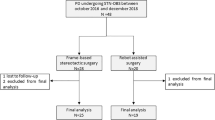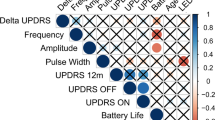Abstract
Few centers have routinely implemented robotic stereotactic systems for deep brain stimulator (DBS) placement. The present study compares clinical outcomes associated with robotic-assisted subthalamic nucleus (STN)-targeted DBS surgery in patients with Parkinson’s disease (PD) to those of the traditional frame-based method. A retrospective chart review was performed (February 2013–June 2017). Thirty-three patients were implanted using the Cosman–Roberts–Wells (CRW) frame and 27 patients were implanted using the ROSA robot. Movement Disorder Society-Unified Parkinson’s Disease Rating Scale (MDS-UPDRS) or UPDRS part III motor scores and levodopa equivalent daily doses (LEDD) were examined preoperatively and at 6, 12, and 24 months of follow-up. Operative times and complication rates were recorded. For the frame-based group, the reduction in the mean MDS-UPDRS part III motor score compared to baseline was 27% both at 6 and 12 months, and 36.7% at 24 months. For the robotic-assisted group, the reduction in the mean motor score from baseline was 17.6% at 6 months, 19% at 12 months and 21.4% at 24 months. The mean LEDD for the frame-based group decreased by 48.7% at 6 months, 56.7% at 12 months, and 29.7% at 24 months. For the robotic-assisted group, the mean LEDD decreased by 42% at 6 months, 45% at 12 months and 50% at 24 months. There were no significant differences in the mean motor scores and the LEDD reduction between the two groups. Operative times tended to be longer for robotic-assisted DBS surgery. Clinical outcomes associated with robotic-assisted surgery are comparable to those with frame-based surgery.
Similar content being viewed by others

References
Kwoh YS, How J, Jonckheere EA, Hayati S (1988) A robot with improved absolute positioning accuracy for CT-guided stereotactic brain surgery. IEEE Trans Biomed Eng 35(2):153–160
Benabid AL, Cinquin P, Lavelle S et al (1987) Computer driven robot for stereotactic surgery connected to CT scan, and magnetic resonance imaging: technological design and preliminary results. Appl Neurophysiol 50:153–154
Gonzalez-Martinez J, Bulacio J, Thompson S et al (2016) Technique, results, and complications related to robot-assisted stereoelectroencephalography. Neurosurgery 78(2):169–180
Lefranc M, Zouitina Y, Tir M et al (2017) Asleep robot-assisted surgery for the implantation of subthalamic electrodes provides the same clinical improvement and therapeutic window as awake surgery. World Neurosurg 106:602–608
Limousin P, Pollak P, Benazzouz A et al (1995) Effect of parkinsonian signs and symptoms of bilateral subthalamic stimulation. Lancet 345(8942):91–95
Hentzog J, Mehta S, Driver-Dunckley E et al (2016) Simplified conversion method for unified Parkinson’s disease rating scale motor examinations. Neurology 86(16):P1.005
Herzog J, Volkman J, Krack P et al (2003) Two-year follow-up of subthalamic nucleus deep brain stimulation in Parkinson’s disease. Mov Disord 18(11):1332–1337
Deuschl D, Schade-Brittinger C, Krack P et al (2006) A randomized trial of deep-brain stimulation for Parkinson’s disease. N Engl J Med 355:896–908
Krack P, Batir A, Blercom Van et al (2003) Five-year follow-up of bilateral stimulation of the subthalamic nucleus in advanced Parkinson’s disease. N Engl J Med 349:1925–1934
Castrioto A, Lozano A, Poon Y et al (2011) Ten-year outcome of subthalamic stimulation in Parkinson’s disease. Arch Neurol 68(12):1550–1556
Kelman C, Ramakrishnan V, Davies A et al (2010) Analysis of stereotactic accuracy of the Cosman-Robert-Wells frame and Nextframe frameless systems in deep brain stimulation surgery. Stereotactic Funct Neurosurg 88:288–295
Bot M, Van den Munckhof P, Bakay R et al (2015) Analysis of stereotactic accuracy in patients undergoing deep brain stimulation using Nexframe and the Leksell Frame. Stereotact Funct Neurosurg 93:316–325
Umemura A, Jaggi JL, Hurtig HI et al (2003) Deep brain stimulation for movement disorders: morbidity and mortality in 109 patients. J Neurosurg 98:779–784
Voges J, Waerzeggers Y, Maarouf M et al (2006) Deep-brain stimulation: long-term analysis of complications caused by hardware and surgical-experiences from a single centre. J Neurol Neurosurg Psychiatry 77:868–872
Funding
None.
Author information
Authors and Affiliations
Contributions
MP collected and analyzed all data, wrote and organized the manuscript, and prepared all tables. ASW assisted with literature searches and manuscript writing. NP, AM, and NH performed patient clinical assessments and managed symptom treatment. NP provided instruction for analyzing clinical data. NP, AM, and NH critically reviewed the manuscript. SV assisted with computing the accuracy of ROSA-assisted DBS lead implantation. FPKH performed all DBS surgeries, critically reviewed and contributed to the manuscript.
Corresponding author
Ethics declarations
Conflict of interest
MP, ASW, NP, SV, AM, NH, and FPKH declare that they have no conflict of interest.
Research involving human participants
This retrospective study was approved by the Institutional Review Board for biomedical research at the University of California, Irvine.
Informed consent
All procedures followed were in accordance with the ethical standards of the responsible committee on human experimentation (institutional and national) and with the Helsinki Declaration of 1975, as revised in 2000. This study was granted a waiver of informed consent as the study was deemed to pose minimal risk to the wellbeing and privacy of the patients included in the study. No patient identifiers were collected or disclosed for the purposes of this study.
Additional information
Publisher's Note
Springer Nature remains neutral with regard to jurisdictional claims in published maps and institutional affiliations.
Rights and permissions
About this article
Cite this article
Paff, M., Wang, A.S., Phielipp, N. et al. Two-year clinical outcomes associated with robotic-assisted subthalamic lead implantation in patients with Parkinson’s disease. J Robotic Surg 14, 559–565 (2020). https://doi.org/10.1007/s11701-019-01025-x
Received:
Accepted:
Published:
Issue Date:
DOI: https://doi.org/10.1007/s11701-019-01025-x



